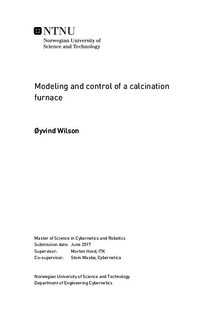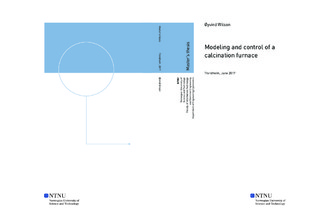| dc.description.abstract | Calcined anthracite is the primary material used in Søderberg electrode paste, prebaked carbon electrodes, aluminium cathodes, and a variety of other carbon products used in the metallurgical industries.
In electrical calcination of anthracite current is passed through the raw material. This heat treats the anthracite, which gets rid of volatile matter and water, and graphitizes the anthracite. The graphitization lower the anthracite's electrical resistivity. The object of the process is to get calcined anthracite with resistivity inside a given range.
Elkem's electric calciner is the process examined in this work. It is in a large degree controlled manually, and the present control leads to inconsistent product results. The main motivation for this work is to develop a controller that yields automatic and consistent control of the process. In this work, the first steps towards this goal is started.
A first principle mathematical model is developed for the process. Mass and energy balances are used, as well as a description of the resistivity change. The electrical properties of the process is also looked upon and modelled. Further the model is simulated and compared to real operational data from Elkem's calcination furnace to check its validity.
Current and voltage is both used as input to see which gives the best result. It is seen that current as an input undoubtedly yields much better results than when voltage is used as input. The introduction of thermal runaway in the model is speculated to be the reason.
The effect of the effective activation energy on the resistivity curve is examined. No general rule for its behaviour is found.
The finished model gives satisfactory matches with all the measured electrical properties except for the resistivity. Since there isn't any observable correlation between the inputs and the measured resistivity, or any correlation between the measure resistance and resistivity, it is suspected that the resistivity measurements are not trustworthy. These measurements is dismissed. For the continuation of this work, the model is assumed verified based on the other measurements (primarily the furnace resistance).
A formulation for an NMPC controller is suggested. Two cases are simulated using the model both as a model for the plant and the model used in the controller. The first case concerns changes of the resistivity set point without any model deviations or disturbances. The second case concerns a change in the raw material's moisture modelled as a disturbance. This case is examined both with and without feed-forward.
The controller works well when there are no disturbances or model deviations. When the change in the raw material's moisture is introduced as a disturbance, the controller is no longer able to reach the desired set point. Using feed-forward fixes this problem, and yields smooth and efficient control to the set point. | |

